
Socotra or Saqatri is an island of Yemen in the Indian Ocean. Lying between the Guardafui Channel and the Arabian Sea and near major shipping routes, Socotra is the largest of the four islands in the Socotra archipelago. Since 2013, the archipelago has constituted the Socotra Governorate.

Panicum (panicgrass) is a large genus of about 450 species of Poaceae grasses native throughout the tropical regions of the world, with a few species extending into the northern temperate zone. They are often large, annual or perennial grasses, growing to 1–3 m (3–10 ft) tall.
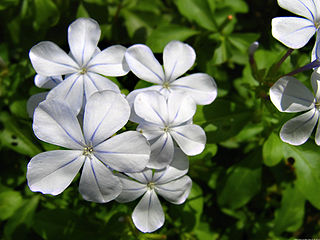
Plumbago is a genus of 23 species of flowering plants in the family Plumbaginaceae, native to warm temperate to tropical regions of the world. Common names include plumbago and leadwort.

Dactyloctenium is a genus of Asian, African, and Australian plants in the grass family. There are about 13 species in the genus in the world, in which 3 are known to occur in India. A common name for the plants is crowfoot grasses.

Lepturus is a genus of plants in the grass family, native to Asia, Africa, Australia, and various islands in the Indian and Pacific Oceans.

Aerva is a genus of plants in the family Amaranthaceae. Its species are native to the palaeotropics, throughout continental Africa, Madagascar and smaller islands, through parts of the Middle East, India, and southeast Asia. Aerva javanica is an alien in northern Australia.

Aloe squarrosa is a species of flowering plant in the Asphodelaceae family. It is from the island of Socotra, Yemen.
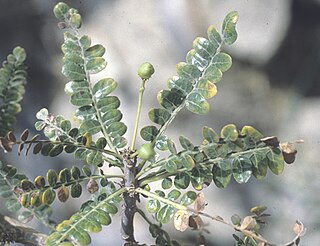
Boswellia socotrana is a species of plant in the Burseraceae family. It is endemic to Socotra, Yemen. Its natural habitats are subtropical or tropical dry forests and subtropical or tropical dry shrubland.

Euphorbia arbuscula is a species of plant in the spurge family (Euphorbiaceae). It is endemic to the archipelago of Socotra in Yemen. Its natural habitats are subtropical or tropical dry forests and subtropical or tropical dry shrubland.

Graderia is a genus of plants in the family Orobanchaceae, which is native to Africa and Socotra. It belongs to the tribe Buchnereae. It is a hemiparasitic taxon.

The Socotra Island xeric shrublands is a terrestrial ecoregion that covers the large island of Socotra and several smaller islands that constitute the Socotra Archipelago. The archipelago is in the western Indian Ocean, east of the Horn of Africa and south of the Arabian Peninsula. Politically the archipelago is part of Yemen, and lies south of the Yemeni mainland.
Friedrich Karl Max Vierhapper was an Austrian plant collector, botanist and professor of botany at the University of Vienna. He was the son of amateur botanist Friedrich Vierhapper (1844–1903), botanical abbreviation- "F.Vierh.".
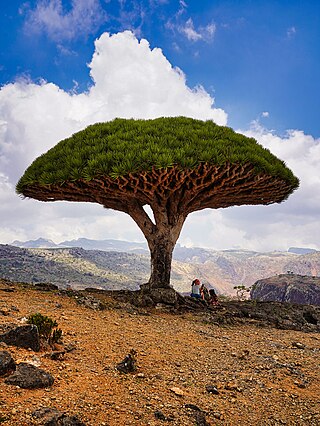
Dracaena cinnabari, the Socotra dragon tree or dragon blood tree, is a dragon tree native to the Socotra archipelago, part of Yemen, located in the Arabian Sea. It is named after the blood-like color of the red sap that the trees produce. It is considered the national tree of Yemen.
Pseudodichanthium is a genus of Asian plants in the grass family. The only known species is Pseudodichanthium serrafalcoides, native to Maharashtra and Oman.

Apluda is a genus of plants in the grass family native to Asia and to various islands in the Indian and Pacific Oceans.
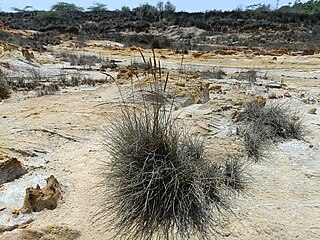
Urochondra is a genus of plants in the grass family. The only known species is Urochondra setulosa, native to northeastern Africa and southwestern Asia. The species grows in coastal sand dunes, salt marshes and estuaries.
Halopyrum is a genus of Asian and African plants in the grass family. The only known species is Halopyrum mucronatum, native to the Indian Subcontinent, Iran, the Arabian Peninsula, Socotra, Madagascar, and eastern + northeastern Africa.
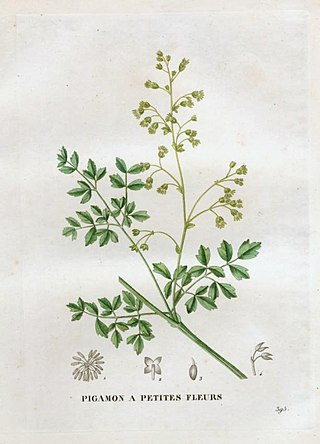
Thalictrum minus, known as lesser meadow-rue, is a perennial herb in the family Ranunculaceae that is native to Europe, Northwest Africa, Yemen, Ethiopia, South Africa, Southwest Asia, and Siberia. It grows on sand dunes, shingle, coastal rocks or calcareous grassland, cliffs and rocky gullies at up to 1,600 to 3,000 m elevation at southern latitudes. It grows to 30 cm (0.98 ft) tall with erect stems and 1 cm (0.39 in) leaves that are highly subdivided, 3-4 ternate to pinnate.

Cissus subaphylla is a low shrub in the grape family Vitaceae. It is endemic to the Yemeni island of Socotra. The plant grows mainly in dry, low-lying areas on alluvial fans or on limestone slopes, and is rarely found above elevations of 300 metres (980 ft), where it is replaced by C. hamaderohensis. It does not have the climbing habit of other Cissus species, and its stems are flattened and gray-green in colour, with relatively small leaves and flowers. The tangled mats of C. subaphylla stems act as a protective covering for plants regularly eaten by goats and other browsing animals; the plant is thus important in the rehabilitation of species such as Dendrosicyos, Maerua and Commiphora.
The wildlife of Yemen is substantial and varied. Yemen is a large country in the southern half of the Arabian Peninsula with several geographic regions, each with a diversity of plants and animals adapted to their own particular habitats. As well as high mountains and deserts, there is a coastal plain and long coastline. The country has links with Europe and Asia, and the continent of Africa is close at hand. The flora and fauna have influences from all these regions and the country also serves as a staging post for migratory birds.
















